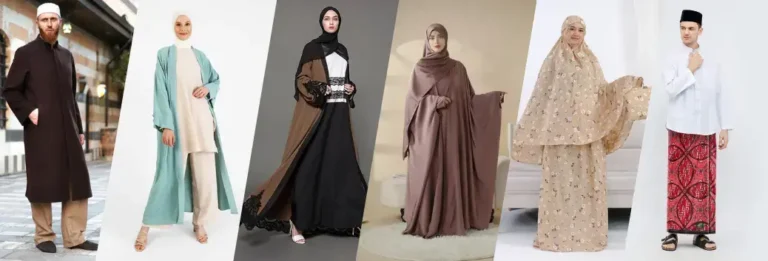The world of fashion is as diverse as its audience, and two terms often discussed in the context of ethical and cultural clothing are Halal Fashion and Modest Fashion. While these concepts share some common ground, they represent distinct approaches to dressing and the values behind it. This article will explore the differences, similarities, and significance of these two growing trends in the global fashion industry.
Understanding Halal Fashion
Halal Fashion refers to clothing and accessories designed and produced in compliance with Islamic principles. The term “halal” means “permissible” in Arabic and extends beyond food to cover other aspects of life, including fashion. Halal fashion is not just about the final product but also about the processes involved in its creation.
Key Features of Halal Fashion:
- Material Compliance: Halal fashion ensures that all materials used—fabrics, dyes, and chemicals—are free from haram (forbidden) substances, such as pig derivatives or alcohol-based products. This is particularly significant in textiles, where certain additives or processes may render the final product non-halal.
- Ethical Production: The production process must align with Islamic ethics, including fair labor practices, humane treatment of workers, and environmentally sustainable practices. This reflects broader Islamic values of social justice and stewardship of the earth.
- Certification: Products are often halal-certified, guaranteeing compliance with religious standards. Certification bodies inspect the supply chain and manufacturing processes to ensure adherence to halal principles. Initiatives like the Global Fashion Halal Standard (GHFS) are instrumental in establishing a structured framework for halal compliance in the fashion industry. The GHFS provides categories like Halal Passport for companies and GHFS Approved for products, ensuring traceability and credibility.
- Traceability: Halal fashion emphasizes transparency in the supply chain, ensuring every step—from sourcing raw materials to the final product—meets Islamic guidelines. This traceability is crucial in building consumer trust and maintaining integrity.
Example:
A halal-certified hijab made from organic cotton and dyed with halal-approved. The manufacturing process avoids harmful chemicals and adheres to ethical labor standards, ensuring the product is both sustainable and religiously compliant.
Understanding Modest Fashion
Modest Fashion focuses on clothing that provides more coverage of the body, adhering to the cultural, personal, or religious preferences of modesty. Unlike halal fashion, modest fashion does not necessarily require compliance with specific religious standards for materials or production processes.
Key Features of Modest Fashion:
- Design-Oriented: Modest fashion prioritizes design elements that ensure coverage. Clothes are often loose-fitting and feature long sleeves, high necklines, and ankle-length hemlines. The goal is to balance style with modesty, offering fashionable choices without compromising on coverage.
- Inclusivity: Modest fashion appeals to people from various backgrounds, including Muslims, Christians, Jews, and others who value modesty for cultural or personal reasons. This inclusivity has helped modest fashion gain traction in global markets.
- No Material Restrictions: While the design emphasizes coverage, there are no specific requirements for the materials used. This allows for greater flexibility in sourcing fabrics and incorporating diverse design elements.
- Global Appeal: Modest fashion has gained popularity as a fashion-forward choice for individuals seeking stylish yet conservative clothing. It is celebrated in various fashion weeks and by major brands worldwide, catering to a wide audience.
Example:
A maxi dress with long sleeves and a loose fit, designed for modest wear but produced without specific halal certification. It may feature vibrant colors, intricate embroidery, or other design elements that appeal to a broad audience.
Key Differences Between Halal and Modest Fashion
| Aspect | Halal Fashion | Modest Fashion |
|---|---|---|
| Focus | Religious compliance in materials and processes | Aesthetic design for body coverage |
| Production Standards | Requires halal certification and ethical practices | No specific production requirements |
| Target Audience | Primarily Muslim consumers | Broader audience seeking modest clothing |
| Scope | Covers the entire supply chain | Limited to clothing design and aesthetics |
| Material Restrictions | Uses halal-approved materials | No restrictions on materials used |
Where Halal and Modest Fashion Overlap
While the two concepts differ in scope and focus, they are not mutually exclusive. Halal fashion is inherently modest because it aligns with Islamic guidelines for clothing, which emphasize modesty. On the other hand, modest fashion can sometimes meet halal standards if the production process adheres to Islamic principles. Both concepts share a commitment to ethical and sustainable practices, making them appealing to socially conscious consumers.
For instance, a halal-certified abaya (a traditional loose-fitting garment) not only fulfills the requirements of halal fashion but also fits the aesthetic criteria of modest fashion. Similarly, modest fashion brands that prioritize ethical practices and avoid haram substances can appeal to consumers seeking halal options.
The Growing Influence of Halal and Modest Fashion
The global modest fashion market is expected to reach $311 billion by 2024, driven by increasing demand from Muslim-majority countries and non-Muslim markets alike. Similarly, halal fashion is carving out its niche, particularly among consumers who value transparency, ethical production, and religious compliance.
The Role of Social Media
Social media has played a significant role in the rise of both halal and modest fashion. Influencers and fashion bloggers from diverse backgrounds have showcased how these styles can be both fashionable and meaningful. Platforms like Instagram, TikTok, and YouTube have become hubs for modest fashion enthusiasts and halal-conscious consumers to discover new trends and brands.
Brand Adaptation
Major brands and retailers are taking note of these growing trends. High-profile names like Dolce & Gabbana, H&M, and Uniqlo have launched modest fashion collections, while smaller brands are seeking halal certifications to cater to niche markets. This shift reflects the increasing purchasing power of Muslim consumers and the global appeal of modesty.
Ethical and Sustainable Practices
Both halal and modest fashion align with broader trends toward sustainability and ethical production. Consumers are increasingly seeking clothing that reflects their values, whether through environmentally friendly materials, fair labor practices, or religious compliance. Halal fashion, in particular, emphasizes these principles as part of its core identity. Initiatives like Halal Track, a platform for traceability in halal fashion products, demonstrate the industry’s commitment to transparency and sustainability.
Conclusion
While halal fashion and modest fashion share some similarities, they represent distinct approaches to clothing. Halal fashion emphasizes compliance with Islamic principles in both design and production, while modest fashion focuses on style and coverage without specific religious or material restrictions. Together, these trends reflect a broader shift toward inclusivity, sustainability, and ethical practices in the fashion industry.
Whether you are looking for religiously compliant clothing or simply prefer modest styles, the rise of halal and modest fashion ensures that there is something for everyone. As these movements continue to grow, they are redefining what it means to dress ethically and fashionably in today’s world.




